Choosing the Best Reverse Osmosis Filter for Your Needs
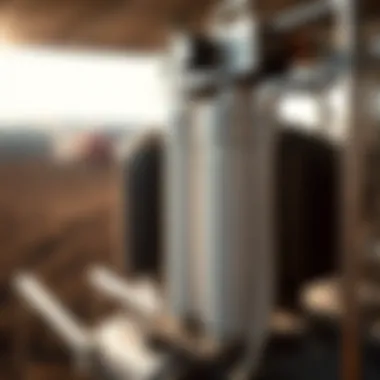
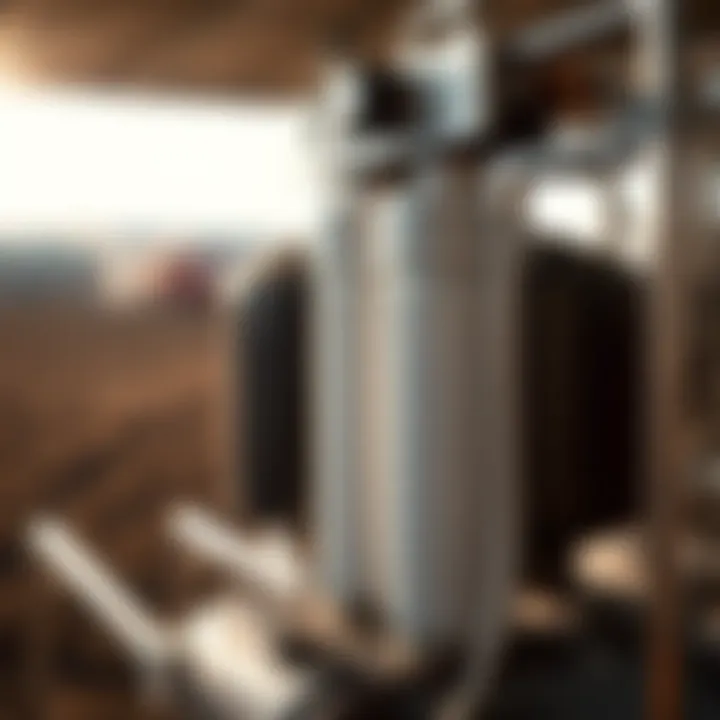
Intro
When it comes to ensuring high-quality water for homes or agricultural settings, understanding the mechanics and nuances of reverse osmosis filters can be a game changer. Whether aiming to enhance the water consumed in urban households or to support the irrigation needs of rural farms, selecting the right filter is crucial. Reverse osmosis systems provide a solution for those concerned about impurities—be it minerals, chemicals, or contamination—affecting either domestic life or crop productivity.
This guide offers a deep dive into the world of reverse osmosis filters, covering the core concepts, recent trends, practical applications, and useful resources. By the end, you’ll be well-equipped to make informed choices tailored to your specific requirements, ultimately optimizing water quality in any context you choose.
Key Concepts and Terminology
Understanding the basic terms and concepts behind reverse osmosis can facilitate better decision-making.
Basic Definitions
Reverse Osmosis (RO): A filtration process that uses a semi-permeable membrane to separate impurities from water. Water is forced through the membrane, allowing only pure water to pass while trapping larger molecules.
Contaminants: Impurities found in water, including salts, heavy metals, and microorganisms that can pose health risks.
TDS (Total Dissolved Solids): A measurement that indicates the combined content of all inorganic and organic substances present in water, which can significantly affect its taste and usability.
Historical Context
The concept of reverse osmosis is not a new one. Its practical applications began in the early 20th century, primarily in the field of desalination—removing salt from seawater to make it potable. Over time, the technology improved significantly, leading to its adoption in residential settings and agricultural applications. Today, reverse osmosis represents a standard in water purification processes across various industries.
Recent Innovations and Trends
There’s a lot happening in the world of reverse osmosis. The latest advancements promise not only better filtration but also more sustainable practices that echo current environmental concerns.
Technological Advancements
Modern reverse osmosis systems now integrate smart technologies that monitor performance and efficiency. Sensors may provide real-time data about water quality and filter life, allowing for timely maintenance and optimization. Recent models often feature multi-stage filtration that enhances the purity of water while prolonging the life of the filters.
Sustainable Practices
The ongoing shift towards green technology influences developments within the reverse osmosis sector. Systems are being designed to minimize water waste—a significant concern in agricultural applications—by employing techniques such as water recycling and energy recovery.
Practical Applications and Techniques
Arming yourself with actionable knowledge about reverse osmosis can yield significant benefits. Here’s how to get started.
Step-by-step Guides
- Assess Water Quality: Test your water to determine the types and levels of contaminants present.
- Select Suitable System: Choose a reverse osmosis system that meets your specific water quality needs.
- Installation: Follow manufacturer instructions or consult a professional for proper installation.
- Maintenance: Keep track of filter lifespan and perform regular checks for optimal performance.
Case Studies
In an agricultural setting, a farmer in California implemented a reverse osmosis system for irrigation. They noticed a dramatic increase in crop yield—up to 20%—due to enhanced water quality. In homes, families reported improved taste and odor of drinking water after installing reverse osmosis filters, indicating not just a preference but a necessity for better health and wellness.
By understanding water quality management through reverse osmosis, you become empowered to contribute positively to the environment and health of your community.
For more detailed insights and resources, consider visiting relevant domains like EPA and Water Quality Association.
Now, as we navigate further into the specifics of operational aspects, installation intricacies, and deeper case studies, each section of this guide will provide thorough understanding aimed at both the novice and the seasoned user.
Understanding Reverse Osmosis
Reverse osmosis (RO) has emerged as a crucial method for ensuring clean water for both agricultural practices and household needs. It is not merely a buzzword in the water filtration industry; it represents a sophisticated process that can make a huge difference. This section delves into the fundamental aspects of RO, discussing its significance in an era where water quality is paramount.
What Is Reverse Osmosis?
Reverse osmosis is a process widely used to remove impurities from water by pushing it through a semipermeable membrane. This membrane acts as a filter, allowing only certain molecules, like water, to pass through while blocking larger particles such as salts, toxins, and other contaminants.
To put it simply, think of RO as a bouncer at a club. Only those with invitations—water molecules—are allowed in, while the riffraff—impurities—are shown the door. This particular way of filtering water results in cleaner, safer water, making it an essential component for anyone looking to improve water quality.
The Science Behind Reverse Osmosis


Now, let’s dive deeper into how this process works. At the heart of reverse osmosis is pressure. By applying force to push the water through the membrane, it separates pure water from pollutants. The difference between regular osmosis and reverse osmosis is fundamentally about direction. In natural osmosis, water moves from an area of low concentration to an area of high concentration. However, in reverse osmosis, pressure facilitates movement in the opposite direction, which is a key element in filtration.
The materials used in membranes are equally important. Typically made from thin-film composite (TFC) or cellulose acetate, these membranes are designed to withstand a variety of water conditions and pressure levels. The efficiency of these membranes dictates the overall effectiveness of the RO system. Plus, understanding this allows consumers to select filters that suit their specific needs, be they for industrial use or home installations.
“The ability to control water quality through meticulous filtration is no longer just a technical advantage; it’s a necessity.”
Reverse osmosis plays a vital role not just in everyday life; it also holds considerable implications for agricultural practices. Farmers depend on high-quality water to maximize crop yields and ensure healthy produce. By understanding reverse osmosis, farmers and enthusiasts alike can make informed decisions that directly impact their operations. The marriage of effective water management and enriched soil health results in sustainable agriculture, something that is increasingly vital in today’s environmentally-conscious society.
Importance of Water Quality
Water quality is not just about the visible clarity of the liquid we consume; it fundamentally impacts our health, agriculture, and the environment at large. In this article, we delve into why understanding water quality is vital, particularly for those involved in agriculture and horticulture.
When it comes to farming, the quality of water used for irrigation directly influences the yield and quality of crops. Clean, contaminant-free water ensures that plants can flourish, absorbing the necessary nutrients without the hindrance of pollutants. Farmers can’t afford to take shortcuts, as the repercussions of using poor-quality water can manifest in a multitude of ways. It could mean stunted growth, lower resistance to pests, and even complete crop failure in extreme cases. Additionally, plants irrigated with contaminated water can absorb harmful substances that then make their way into the food chain, posing risks not just to the plants themselves but also to those consuming the final product.
Moreover, the connection between water quality and soil health is significant. Water serves as a fundamental carrier of minerals and nutrients from the soil. If the water is tainted, it may introduce harmful toxins, leading to impaired soil quality over time.
Thinking of quality water as an investment rather than an expenditure will pay off down the line. Cleaner water can help in securing higher yields, healthier crops, and can even save money in the long run by minimizing the need for fertilizers and other costly interventions.
"Water is the driving force of all nature." – Leonardo da Vinci
Impact on Agriculture and Horticulture
The effects of water quality in agriculture are profound. In essence, every farmer should prioritize the quality of their water source. For instance, take a vegetable farmer using well water. If that water contains high levels of nitrates and other harmful chemicals, it may cause crops to produce less favorable results, leading to economic losses. This chemical runoff often comes from nearby industrial sites or over-fertilized farmland, emphasizing the need for rigorous water testing.
In cultivating fruits, poor water can lead to bitter or undesirable flavors that compromise not just quality but marketability. Grapes, for example, are particularly sensitive; growers are tasked with ensuring their irrigation systems pull from clean water sources to maintain desired taste profiles for wines.
For horticultural businesses, using contaminated water can adversely affect ornamental plants, reducing their aesthetic appeal and potentially leading to unsatisfied customers. And, let's face it, no landscaping company wants to explain to clients why their newly planted roses wilted after a few weeks.
Understanding the source of water – whether it's ground, surface, or municipal – is essential. Each type has its own set of challenges and benefits, and farmers must tailor their practices accordingly. Most importantly, implementing high-quality reverse osmosis filters can alleviate many of these concerns, offering a reliable solution to ensure clean and safe water is always at hand.
Health Implications of Contaminated Water
Water quality is a matter of life and death, quite literally. The health risks associated with consuming contaminated water are well documented, ranging from acute diseases to long-term health problems. For farmers drinking from their irrigation water source or using it without proper treatment, the stakes are incredibly high. Pathogens such as bacteria, viruses, and parasites can be lurking in water supplies, leading to serious health repercussions.
For instance, water tainted with E. coli can lead to dire consequences if it finds its way into the food supply. Farmers, their families, and consumers all risk severe gastrointestinal disorders, and in extreme cases, kidney failure.
Furthermore, chemical contaminants – like heavy metals, pesticides, and fertilizers – pose multi-faceted health concerns. Over time, long-term exposure can lead to a range of chronic illnesses, including cancer and endocrine system disruptions.
The sad reality is that many farmers may not be aware of the harmful substances lurking in their water. Routine testing is an often overlooked necessity. Regular checks not only help identify contaminants but also go a long way in preventing larger health crises and meeting farming regulations.
Overall, as awareness increases regarding the importance of water quality, farmers are recognizing the need for action. Implementing cutting-edge technology such as reverse osmosis filters can significantly reduce the risks posed by both biological and chemical contaminants, safeguarding health while improving agricultural outcomes.
As we move forward in this guide, we will explore how to incorporate these systems successfully, keeping not just farms thriving but ensuring that the water quality meets the necessary standards for both health and productivity.
Evaluating Reverse Osmosis Filters
When it comes to purifying water, reverse osmosis filters are a go-to solution for both agriculture and home use. Understanding how to evaluate these filters will help you navigate the options available, ensuring you make choices that fit your specific needs. Evaluating reverse osmosis filters isn't just about picking any old brand off the shelf; it's about diving into the nitty-gritty of performance, durability, and technology. This section digs into the essential features and technological advancements you should keep an eye out for when assessing different models.
Key Features to Consider
Filtration Capacity
Filtration capacity is a pivotal element when it comes to evaluating reverse osmosis filters. Essentially, this tells you how much water the system can filter in a given timeframe—often measured in gallons per day (GPD). A higher capacity is particularly beneficial for larger households or farms where water consumption is higher. You don't want to fit a robust filtration system to a trickle of a supply. For example, a system with a capacity of 50 GPD might suffice for a small household, but a bustling farm may require closer to 100 GPD or more to keep up with daily demands.
The unique feature of filtration capacity lies in its ability to cater to varying household needs. However, it's important to remember that with higher capacity comes potentially noisier operations and the need for more complex maintenance.
Membrane Quality
Membrane quality cannot be overstated when you're evaluating a reverse osmosis system. This is the heart of the filtration process, where the actual removal of contaminants happens. High-quality membranes made from polyamide or thin-film composite typically demonstrate better efficiency. These materials can handle a broader spectrum of contaminants, ensuring that water quality meets health standards.
The critical advantage of a top-tier membrane is its longevity. While cheaper membranes might save you a buck upfront, they often need more frequent replacements, costing more long-term. Hence, investing in quality leads to peace of mind when it comes to the safety of your water supply.
System Size
System size is another factor worth serious consideration when evaluating reverse osmosis filters. The dimensions of the unit can impact not just where you can install it but also its capacity to handle water pressure and the total volume of water filtered. Generally, a larger unit can filter more water at once and might provide a more consistent flow, rendering it ideal for agricultural settings.
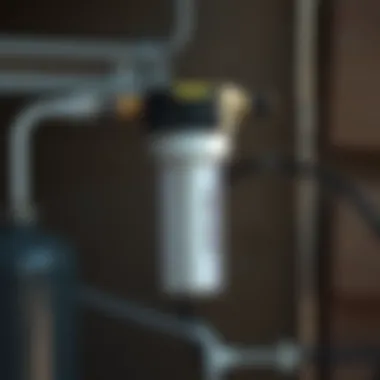
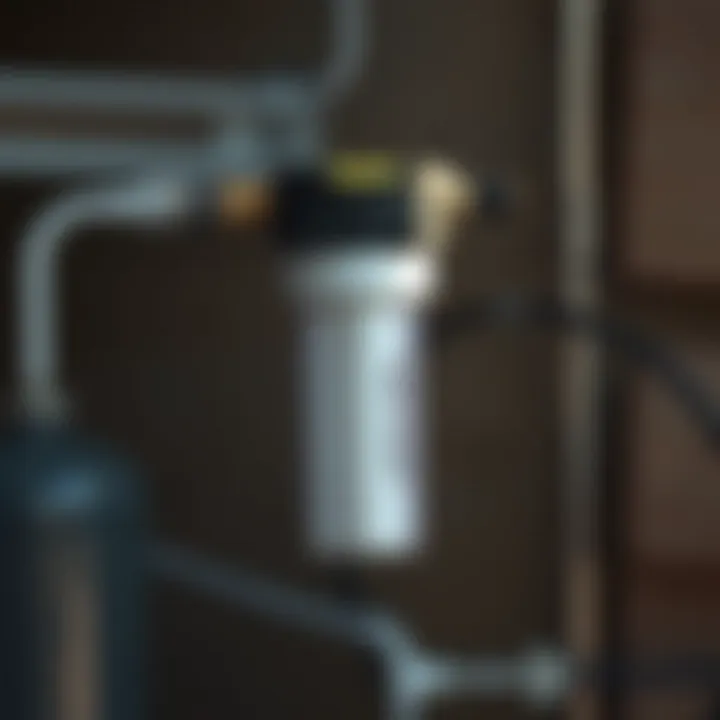
Furthermore, the unique feature of the size is that it can influence maintenance as well. Smaller systems can be easier to manage manually but might result in higher replacement cycles for filters. Larger systems often require professional servicing, which can be both a pro and a con depending on your comfort level and technical expertise.
Technological Advancements
Smart Technology Integration
In today’s age, smart technology integration offers a remarkable edge in evaluating reverse osmosis systems. These units can connect with your home network, enabling remote control and monitoring through mobile apps. This means you can keep tabs on water quality, monitor filter life, and even receive alerts when maintenance is due, all from your smartphone.
The benefit here lies in convenience and efficiency. By receiving notifications or analyzing water usage and quality data through an app, farmers and homeowners can optimize their water usage effectively. Yet, technology often comes with a learning curve; not everyone finds tech-savvy solutions intuitive at first.
Energy Efficiency
Energy efficiency has become a focal point in evaluating reverse osmosis filters and for good reason. Many new models are designed to use less water and energy during the filtration process, which can lead to substantial savings on utility bills over time. This is an essential feature for agriculturalists or households striving to minimize their ecological footprint while maximizing productivity.
A standout aspect of energy-efficient systems is their dual functionality—some of these systems are designed to operate on solar power, making them even more appealing for remote areas. On the flip side, energy-efficient systems may have higher upfront costs, which could be a concern but is often offset by long-term savings.
Smart technology and energy efficiency are paving the way for a future with better water purification and lower operational costs.
By considering these pivotal features and keeping abreast of new technological trends, you can make an informed decision that aligns perfectly with your water quality needs.
Top Reverse Osmosis Filters Reviewed
When it comes to ensuring clean, quality water for homes or agricultural purposes, selecting the right reverse osmosis filter can be an uphill battle. However, knowing the top filters available can make this decision significantly more manageable. This section will delve into valuable insights about some of the leading reverse osmosis filters, evaluating them based on performance, efficiency, and usability. By carefully examining these options, individuals can make informed choices that cater to their specific requirements and goals.
Filter Comparison Overview
In the pursuit of the best reverse osmosis filter, a comparison across different models is crucial. Here’s a snapshot of what to look for when making your selection:
- Filtration Capacity: How much water can the system produce in a day? This factor is pivotal for both home use and agricultural needs.
- Membrane Quality: What type of membrane is employed? The quality directly influences purification efficiency.
- System Size: Is the filter compact, or does it require significant space? This is important for household placement as well as large-scale implementations.
Comparing models based on these features allows for a strategic understanding of what each filter offers and how it meets specific needs. This overview can help narrow down which reverse osmosis filter aligns best with your priorities.
Analysis of Popular Models
Model A
Focusing on Model A, a standout feature is its advanced filtration technology. This model employs a multi-stage process, meaning it does not just filter the water; it layers several techniques to ensure purity. One of its key characteristics is efficiency—this system delivers a high volume of purified water while managing to keep waste to a minimum. Its unique feature includes a smart monitor that alerts users when filters need a change, reducing the guesswork involved in maintenance. However, it has a slightly higher initial cost, which might deter budget-conscious buyers, but the long-term savings in water quality could outweigh this expense.
Model B
Looking at Model B, it captures attention for its compact design. Ideal for those with limited space, this filter does not skimp on performance, offering robust filtration in a fit-for-purpose manner. Its key feature is low energy consumption, making it an eco-friendly option as well. One standout characteristic is its membrane longevity, which promises longer life than many competitors. However, some users may find it lacks emergency support for maintenance issues, which could be a disadvantage during peak usage times.
Model
Finally, Model C sets itself apart with its user-friendly installation process. This model is ideal for individuals who are not tech-savvy. It is marketed primarily for home use but has capabilities suitable for light agricultural tasks. A notable aspect is its built-in water storage tank, which allows for a continuous supply of purified water. While this can be beneficial, a potential downside is its size, making it less appropriate for small kitchens or tight spaces.
Installation and Setup
Setting up a reverse osmosis (RO) filter properly can make all the difference. It's not just about getting the equipment and hooking it up; there are several factors that play a crucial role in ensuring the system operates effectively and benefits the user fully. The installation process sets the foundation for the performance of the RO filter. If the installer overlooks even minor details, it can lead to inefficiencies, wasted water, and frustrated users. Therefore, understanding the specifics around installation and setup becomes paramount.
Pre-Installation Considerations
Before diving into the installation of an RO filter, a bit of forethought can save heaps of trouble down the line. Here are some key points to mull over:
- Location: The placement of the RO unit matters a lot. It should have access to a cold water line, a drain, and an electrical outlet if it's an electrically powered model. A clutter-free space that’s easy to access for maintenance is best.
- Water Source Quality: Assess your water supply beforehand. Knowing the degree of contaminant levels will dictate the type of RO system you need. High iron concentrations, for example, can clog membranes quite quickly.
- Water Pressure: This is crucial. A typical RO system requires a water pressure of at least 40 psi to work efficiently. If your pressure falls below this, you might need a booster pump.
- Drain Type: Most RO systems need a specific type of drain to dispose of waste water effectively. It’s essential to confirm that you have the right plumbing setup.
- Hardware Compatibility: Some systems might come with specific requirements for additional fittings. Double-check your unit’s manual to see if you need anything extra, like connectors or tools.
Being aware of these concerns can prevent myriad headaches later on. As the old saying goes, "An ounce of prevention is worth a pound of cure."
Step-by-Step Installation Process
Once you've ticked off all pre-installation considerations, you’re all set for the installation. Here’s a straightforward guide that'll make the process smoother:
- Unbox and Inspect: Carefully open the package and take stock of all parts. Missing pieces can hamper your progress later.
- Turn Off Water Supply: Before starting, shut off the cold water supply line. This is a must for preventing leaks.
- Install the Faucet: If your RO system comes with a dedicated faucet, now’s the time to attach it. Drill a hole if necessary, ensuring it aligns well with your sink area.
- Mount the RO Unit: Locate a suitable place to mount your system under the sink or in the chosen location. Make sure it’s secure and level.
- Connect Tubes: Attach the feed water line to the cold water line, ensuring it's snug but not overly tight. Next, connect the waste and product water lines to their respective ports on the RO unit.
- Attach the Storage Tank: Connect the tank to the RO unit with the designated tubing. This tank holds the filtered water until you're ready to use it.
- Turn On Water Supply: Slowly turn the water supply back on. Watch for leaks in all connections to ensure everything is sealed correctly.
- Test the System: Finally, run the system for a few minutes to check for proper functioning. It should fill the storage tank without any hitches.
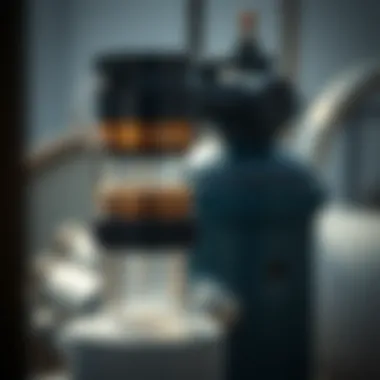

"Proper installation paves the path to years of clean water, while shoddy work can lead to frustration and costly repairs."
By following these steps methodically, installing an RO filter can become a manageable task for most homeowners or farmers. As the saying goes, "Take it one step at a time, and soon enough, you will be drinking cleaner, better-tasting water." For more insights on the topic, you can check out Wikipedia on Reverse Osmosis or National Centers for Environmental Information.
Routine Maintenance and Troubleshooting
Keeping your reverse osmosis system in prime condition is crucial for ensuring that the water it produces remains clean and safe. Routine maintenance not only extends the life of your filter but also guarantees optimal performance, safeguarding your home or agricultural operations from potential water quality issues. Maintaining your system can also lead to significant cost savings over time, preventing costly repairs or replacements that stem from neglect.
Maintenance Schedule
Establishing a regular maintenance schedule is vital for the longevity of your reverse osmosis filter. Here's a general guide to help you manage upkeep effectively:
- Quarterly: Inspect the filter housing for any signs of leakage. A simple visual check can uncover issues before they escalate into major problems.
- Bi-Annually: Replace the pre and post-filters. These filters capture sediment and chlorine, enabling the RO membrane to function effectively.
- Annually: Change the reverse osmosis membrane. This membrane is the heart of the system, and regular replacement ensures that contaminants are filtered adequately.
- Every Two Years: Sanitize the system. This step involves cleaning the tank and water lines to prevent bacterial growth.
"A stitch in time saves nine." Regular maintenance is like that stitch; the sooner it’s done, the less likely it is that you’ll face more serious problems later on.
Common Issues and Solutions
Even the best-maintained systems can occasionally run into trouble. Knowing how to troubleshoot common issues can save you time and worry. Here’s a rundown of typical problems you may encounter with your reverse osmosis system, along with their likely solutions:
- Low Water Pressure: This might be caused by clogged pre-filters. A simple solution here is to replace the pre-filters to restore proper water flow.
- Unusual Tastes or Odors: If the purified water has an off taste or smell, it may indicate that the membrane has reached the end of its life cycle and needs replacing.
- Frequent Leaks: Check for loose fittings or damaged O-rings. Tightening connections or replacing worn parts will often resolve these issues.
- Slow Production Rate: This could suggest that the membrane is dirty or degraded. Cleaning or replacing the membrane can usually get things back to normal.
In essence, proactive maintenance and quick troubleshooting not only enhance the performance of your reverse osmosis filter but also ensure you’re producing clean and safe water, which is the ultimate goal for any user, be it for home use or in agriculture.
Cost Analysis
Cost analysis is a fundamental aspect when considering a reverse osmosis filter. Understanding the financial implications involved in both the initial purchase and the long-term operating costs can significantly affect decision-making for potential buyers. For many, it’s not just a matter of choosing an affordable option but also weighing the value over time. When you think about investing in water filtration, you look at more than just the price tag. You team every dollar spent with the potential benefits it can yield, making it crucial to grasp both expected expenses and utility. In this section, we will explore two pivotal areas: the initial investment versus long-term savings and a comparative analysis of various models.
Initial Investment vs. Long-Term Savings
Every penny counts, especially for those in agriculture where every drop can directly impact the yield. The initial investment can vary widely based on brand, model, and features. Generally, reverse osmosis systems can range from a few hundred to a couple thousand dollars. However, what's often overlooked is the long-term savings these systems can offer.
- Filtering Efficiency: Quality systems do not just filter out contaminants; they also contribute to better crop health, which can lead to higher yields.
- Maintenance Costs: Higher-end models may have pricier upfront costs but typically require fewer repairs and less frequent membrane replacements, leading to savings down the line.
- Water Quality: Improved water quality can reduce the need for additional treatments or amendments, saving costs on these associated products.
To illustrate, consider a mid-range system costing around $600, which lasts about five years with proper maintenance. If this system results in a slight increase in yield and reduces the need for additional fertilizers, farmers might find the investment paying off more than just handsomely.
Comparative Costs of Various Models
Now that we’ve laid down the importance of understanding initial costs versus savings, let’s delve into the comparative costs of various models. Not all reverse osmosis filters are created equal; hence it’s beneficial to examine how different models stack up against each other.
- Model A: This entry-level filter costs approximately $300, offering basic filtration. Ideal for smaller households but may not perform well under heavy demand.
- Model B: Mid-range, priced at about $750, boasts higher filtration capacity and advanced membranes. While pricier, this model accounts for longer lifespan and better efficiency.
- Model C: Top-of-the-line units can soar to $1,500 or more. They usually feature smart technology and energy-efficient components, making them suitable for larger agricultural operations where quality and quantity of water are essential.
Thoroughly comparing these models not only shines a light on upfront costs but allows one to see the benefits over time. Investing in more efficient systems leads to better resource management and can ultimately save considerable money in the long run.
"When evaluating the cost of a reverse osmosis filter, consider the long journey, not just the first step."
Ending
In concluding this comprehensive guide, it becomes apparent that selecting the right reverse osmosis filter is not just a chore, but a crucial step toward ensuring optimal water quality for various uses. The importance of this topic cannot be overstated, especially for those in agriculture and horticulture where water quality directly impacts crop health and yield. By understanding the differences between various filter models, you empower yourself to make decisions that'll effectively suit your unique circumstances.
Each element discussed throughout this article—from installation tips to routine maintenance—is designed to maximize your investment, providing you not just with clean water but confidence in its purity. As echoed in the previous sections, the proper selection of an RO system can save you long-term costs and prevent health issues that arise from consuming contaminated water. The right filter can enhance the taste of drinking water and improve the effectiveness of irrigation systems, which benefits both farmers and consumers alike.
To ensure you're investing wisely, keep in mind that the cheapest option isn't always the best. Durability and efficacy must outweigh initial costs.
Final Recommendations
As you navigate the myriad options available, consider your specific needs—whether you’re supporting a small home vegetable patch or managing a larger commercial operation. It's advisable to assess factors like filtration capacity, the quality of components, and system size. Here’s a quick recap of recommendations:
- Filter Capacity: Choose a system that aligns with your consumption needs, ensuring it can handle peak usage without compromising effectiveness.
- Quality of Components: Invest in models that utilize high-grade membranes and filters, even if they come at a higher price point initially. Long-term performance and reliability often justify this upfront cost.
- Simplicity in Installation: Opt for user-friendly systems, particularly if you plan on DIY installation; this saves both time and potential headaches down the road.
Finally, don’t forget to factor in maintenance schedules and cost to replace filters down the line. An optimal choice lays the groundwork for cleaner water and peace of mind.
Future Trends in Water Filtration Technology
As we look to the horizon of water filtration technology, it's clear advancements are poised to streamline and enhance filtration processes significantly. Innovations such as smart technology integration are making waves, enabling systems to monitor water quality in real-time and automatically notify users when a change occurs.
Moreover, energy-efficient RO systems are on the rise, catering not only to environmental consciousness but also to cost savings on electricity bills. The advancement of compact filter units is another trend; these systems fit neatly into tight spaces without sacrificing performance.
Finally, attention to sustainability cannot be overlooked. The quest for biodegradable filter materials and more efficient water reclamation processes is gaining traction, promising to lessen the environmental impact associated with traditional filtration methods. Bearing these trends in mind will empower both consumers and farmers to adopt technologies that not only meet their needs but also contribute positively to the environment.
With these insights and recommendations, you are now better equipped to identify the best reverse osmosis filter for your situation. Whether it’s your home’s drinking water or the lifeline of your crops, your choices ultimately set the stage for success.















